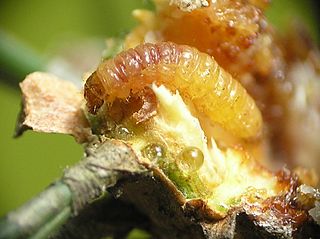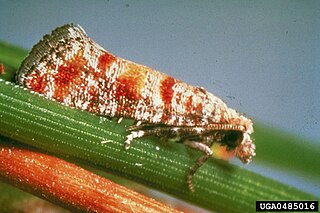
Rhyacionia buoliana, the pine shoot moth, is a moth of the family Tortricidae. It is native to North Africa, North Asia, and Europe, and invasive in North America and South America.

Rhyacionia is a genus of moths belonging to the subfamily Olethreutinae of the family Tortricidae.

Retinia resinella, the pine resin-gall moth, is a moth of the family Tortricidae.
Epinotia rubiginosana is a moth of the family Tortricidae. It is found from Europe to eastern Russia, China, Korea and Japan.

Retinia cristata is a moth of the family Tortricidae. It is found in Japan, Korea, northern and central China, Taiwan and Thailand.
Retinia monopunctata is a moth of the family Tortricidae. It is found in Japan, northern China and Russia.

Rhyacionia pinicolana is a moth of the family Tortricidae. It is found from northern and central Europe to eastern Russia, China, Japan and Korea.

Rhyacionia pinivorana, the spotted shoot moth, is a moth of the family Tortricidae. It is found from northern and central Europe to eastern Russia, China, Korea and Japan.

Zeiraphera ratzeburgiana, the spruce bud moth or Ratzeburg tortricid, is a moth of the family Tortricidae. It is found from northern and central Europe to eastern Russia and China. Zeiraphera ratzeburgiana is a taxonomically similar species to Zeiraphera canadensis and can only be distinguished by an anal comb found in Z. canadensis.

Rhyacionia frustrana, the Nantucket pine tip moth, is a moth of the family Tortricidae. It is found in the United States from Massachusetts south to Florida, west to Missouri, Oklahoma, Texas and California. It is also found in the Dominican Republic, Cuba, Jamaica, Mexico (Oaxaca), Guatemala, Honduras and Nicaragua.

Rhyacionia adana, the Adana tip moth, is a moth of the family Tortricidae. It is found in north-eastern North America, including Massachusetts, Pennsylvania, Virginia, Michigan, Wisconsin and Ontario.

Rhyacionia bushnelli, the western pine tip moth, is a moth of the family Tortricidae. It is found in the United States, including Alabama, Nebraska, North Dakota and Montana.

Rhyacionia subtropica, the subtropical pine tip moth, is a species of moth of the family Tortricidae. It is found in the United States in southern Alabama and Florida. It has also been recorded from Cuba and Belize.

Rhyacionia hafneri is a species of moth of the family Tortricidae. It is found in the Czech Republic, Hungary, Croatia, Bulgaria and Slovenia.
Rhyacionia dolichotubula is a species of moth of the family Tortricidae. It is found in Yunnan, China.
Rhyacionia dativa is a species of moth of the family Tortricidae. It is found in China, Taiwan, Korea, Japan and Russia.
Rhyacionia washiyai is a species of moth of the family Tortricidae. It is found in Japan on the island of Hokkaido.
Rhyacionia insulariana is a species of moth of the family Tortricidae. It is found in China.
Rhyacionia leptotubula is a species of moth of the family Tortricidae. It is found in Heilongjiang and Yunnan in China.

Rhyacionia logaea, the Elgin shoot moth, is a species of moth belonging to the family Tortricidae. It was previously considered a subspecies of Rhyacionia duplana, the summer shoot moth. It is now considered the sister species of R. duplana.












